
The guanaco is a camelid native to South America, closely related to the llama. Guanacos are one of two wild South American camelids; the other species is the vicuña, which lives at higher elevations.
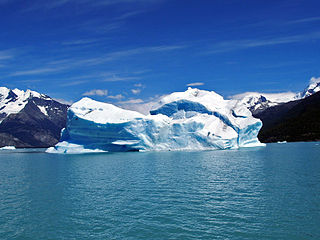
Los Glaciares National Park is a federal protected area in Santa Cruz Province, Argentina.

The Lago Puelo National Park is a national park of Argentina, located in the northwest of the province of Chubut, in the Patagonia region of South America. It has an area of 276.74 square kilometres. It was created to protect its scenic landscape and the Valdivian flora to augment that of the nearby Los Alerces National Park. Originally an annex to Los Alerces, it was declared a National Park and independent reserve in 1971.

Douglas Rainsford Tompkins was an American businessman, conservationist, outdoorsman, philanthropist, filmmaker, and agriculturalist. He founded the North Face Inc, co-founded Esprit and various environmental groups, including the Foundation for Deep Ecology and Tompkins Conservation.

Pumalín Douglas Tompkins National Park is a 400,000-hectare (1,000,000-acre) national park in the Palena Province of Chile, created by Tompkins Conservation, which was endowed and led by the American business magnate Doug Tompkins and his wife, former CEO of Patagonia, Inc., Kris Tompkins. Designated a Nature Sanctuary in 2005, Parque Pumalín was Chile's largest private nature reserve and operated as a public-access park, with an extensive infrastructure of trails, campgrounds, and visitor centers. By an accord announced on 18 March 2017, the park was gifted to the Chilean state and became a national park.

Torres del Paine National Park is a national park encompassing mountains, glaciers, lakes, and rivers in southern Chilean Patagonia. The Cordillera del Paine is the centerpiece of the park. It lies in a transition area between the Magellanic subpolar forests and the Patagonian Steppes. The park is located 112 km (70 mi) north of Puerto Natales and 312 km (194 mi) north of Punta Arenas. The park borders Bernardo O'Higgins National Park to the west and the Los Glaciares National Park to the north in Argentine territory. Paine means "blue" in the native Tehuelche (Aonikenk) language and is pronounced PIE-neh. It was established as a National Park in 1959.

Cerro Castillo National Park is a nature reserve of Chile located in the Aysén del General Carlos Ibáñez del Campo Region, south of Coyhaique. The park is named after Cerro Castillo, its highest mountain and main attraction. The Carretera Austral passes through the park.
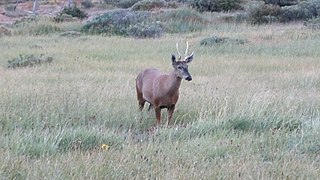
The south Andean deer, also known as the southern guemal, south Andean huemul, southern huemul, or Chilean huemul or güemul, is an endangered species of deer native to the mountains of Argentina and Chile. Along with the northern guemal or taruca, it is one of the two mid-sized deer in the Hippocamelus genus and ranges across the high mountainsides and cold valleys of the Andes. The distribution and habitat, behaviour, and diet of the deer have all been the subject of study. The viability of the small remaining population is an outstanding concern to researchers.
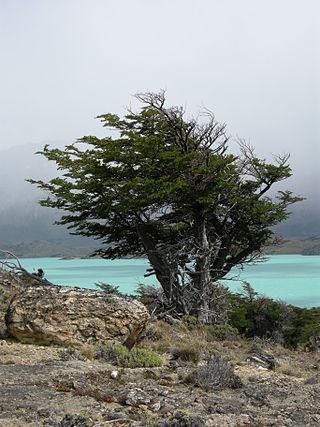
Perito Moreno National Park is a national park in Argentina. It is located in the western region of Santa Cruz Province on the border with Chile. It has an area of 126,830 hectares of mountains and valleys at a height of 900 metres above sea level.
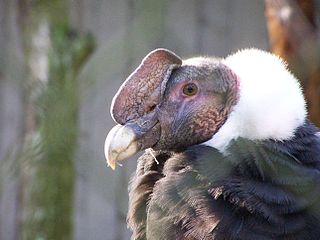
The wildlife of Chile is very diverse because of the country's slender and elongated shape, which spans a wide range of latitude, and altitude, ranging from the windswept coastline of the Pacific coast on the west to northern Andes to the sub-Antarctic, high Andes mountains in the east. There are many distinct ecosystems.
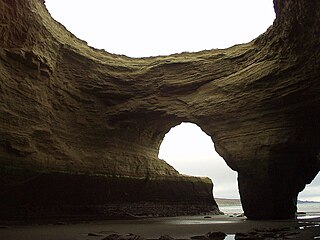
Monte León National Park is a federal protected area in Santa Cruz Province, Argentina. Established on 20 October 2004, it houses a representative sample of the steppe and Patagonian coast biodiversity in good state of conservation, as well as several paleontological sites of high value. It runs along 36 km (22 mi) of the southern Argentine Sea coastline.
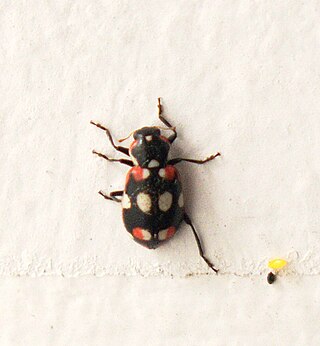
The Environment of Argentina is characterised by high biodiversity.

Kristine Tompkins is the president and co-founder of Tompkins Conservation, an American conservationist and former CEO of Patagonia, Inc..

Nahuel Huapi National Park is the oldest national park in Argentina, established in 1922 as Parque Nacional de Sud and reconfiguered in 1934. It surrounds Nahuel Huapi Lake in the foothills of the Patagonian Andes. The largest of the national parks in the region, it has an area of 7,050 km2 (2,720 sq mi), or nearly 2 million acres. Its landscapes represent the north Patagonian Andean Zone consisting of three types, namely, the Altoandino, the Andino-Patagónico and the Patagonian steppe. It also represents small parts of the Valdivian Rainforest.

Conservación Patagónica was a conservation group with a mission "to create national parks in Patagonia that save and restore wildlands and wildlife, inspire care for the natural world, and generate healthy economic opportunities for local communities." Founded in 2000 by Kristine Tompkins, former CEO of Patagonia, Inc, Conservación Patagónica first focused on the creation of Monte León National Park in Argentina, the country's first coastal national park. The group played the central role in securing the funds for the purchase of Estancia Monte Leon and in creating long-term management plans for the new national park. As of December 31, 2018 Conservación Patagónica has merged into Tompkins Conservation.
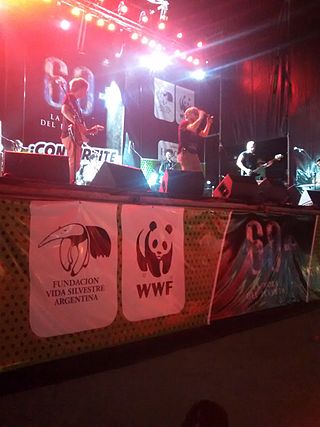
Fundación Vida Silvestre Argentina is a civil association founded on June 29, 1977, working to address the main environmental issues in Argentina. Its mission is to propose and implement solutions for nature conservation, promote the sustainable use of natural resources, and encourage responsible behavior in the context of climate change. The foundation achieves its goals through various actions, including the protection of natural areas, advocating for environmental legislation, promoting awareness and education, and encouraging responsible consumption and production.

The Patagonian grasslands (NT0804) is an ecoregion in the south of Argentina and Chile. The grasslands are home to diverse fauna, including several rare or endemic species of birds. There are few protected areas. The grasslands are threatened by overgrazing by sheep, which supply high-quality merino wool. Efforts are being made to develop sustainable grazing practices to avoid desertification.

The South American cougar, also known as the Andean mountain lion or puma, is a cougar subspecies occurring in northern and western South America, from Colombia and Venezuela to Peru, Bolivia, Argentina and Chile.
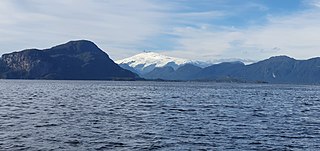
Melimoyu National Park is a protected area of Chile in the comuna of Cisnes, in the Aysén Region. The land for the creation of the park was assembled from public lands and estates donated by Tompkins Conservation, an organization founded by American conservationists Kristine and Douglas Tompkins, as part of a collaborative project to create a "National Parks of Patagonia Network".
Rewilding Argentina is an Argentine nonprofit conservation organization. It purchases private land, restoring ecosystems and developing wildlife corridors, then donates the land for national parks. The organization also reintroduces native species. Founded in 2010 by Argentine conservationists, Rewilding Argentina was preceded by Conservation Land Trust, which was established by Doug Tompkins in 1992.
























